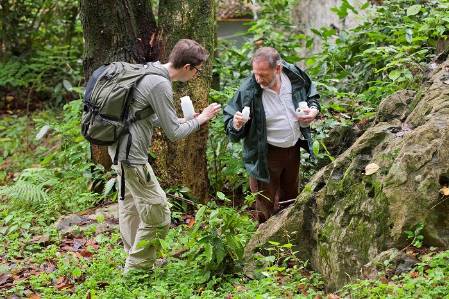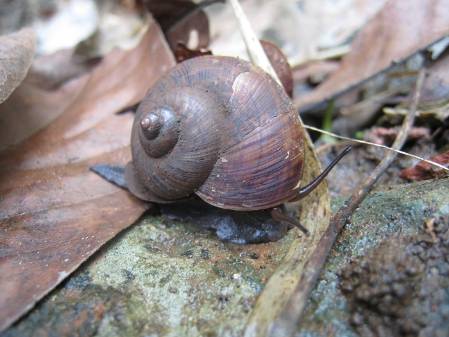Today I am heading off on a plane to Vietnam. Not for a sumptuous seaside sojourn or a historic amble around Hanoi, no instead I will be on fieldwork collecting terrestrial slugs and snails in the national parks of Vietnam.
I'm Jon Ablett, curator of non-marine Mollusca and Cephalopoda at the Museum. I've been on collecting trips to Vietnam before in 2007, 2011 and 2012, but I'm really looking forward to heading back there not only for the wonderful food, landscape and people (and did I mention the food?), but also for the interesting slugs and snails that we hope to find.
 Collecting snails in Vienam in 2011; definitely not a competition to see who has found the best specimen.
Collecting snails in Vienam in 2011; definitely not a competition to see who has found the best specimen.
Why Vietnam? Well, Vietnam is an amazingly diverse country with a broad latitudinal range - from north to south it is over 1,000 miles long. It also has a wide altitudinal range, from over 3,000m in the Hoang Lien Mountains in northern Vietnam, to coastal lowlands and the Mekong Valley.
The Annamese Mountains, which run north to south between Vietnam, Laos and NE Cambodia, are the most extensive limestone hill ranges in Asia. Snails require calcium to form their shells, and as a rule snail diversity increases as the amount of calcium in the environment increases. The rich calcium limestone in these mountains provides incredibly diverse habitats for a highly diverse range of molluscan species that, until now, have barely been studied.
Why snails?
Apart from the fact that I am the curator in charge of the land snail (and cephalopod...) collections at the Museum, there are more recorded extinctions of land snails than for all other animal groups combined. This makes land snails a key group for recognising why and where extinctions are taking place. It also means that snails could be used to demonstrate the effectiveness of various conservation measures, by acting as sensitive indicators of environmental change.
Also, since the Museum has a large historical collection of slugs and snails from Vietnam, by collecting specimens over a variety of timescales we can look at changes within and between species.
 Cyclophorus sp. in leaf litter. Notice the trap door like operculum by the tail.
Cyclophorus sp. in leaf litter. Notice the trap door like operculum by the tail.
The aim of our work in Vietnam is to collect new terrestrial land snail material to enhance the collections of both the Natural History Museum and the Vietnam National Museum of Nature, to provide tissue samples for molecular work, and to test new collection and storage techniques for our frozen tissue collections.
My colleagues and co-conspirators for our fieldwork include Museum staff and students as well as scientists from Nottingham University, the Zoological Society of London, the Vietnam National Museum of Nature and the Vietnam National Park Service. I hope that throughout my time in Vietnam I can tell you a little bit about the work that will be done by me and the team, explain some of the collection and preservation techniques we use and also a little about the trials and tribulations, highlights (and lowlights?) that occur along the way.
I'm just off to finish up packing up my collection equipment, suncream and mosquito repellent and hopefully the next time I blog I will be settled in Hanoi with a few new stories to tell.


